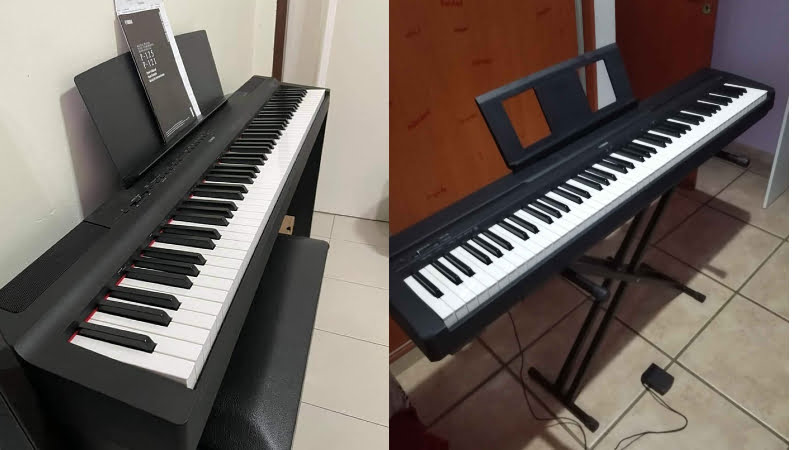Yamaha is one of the most well-known instrument brands out there, that’s why I was very happy to make a Yamaha P45 vs P125 comparison where I test out all the features of these two instruments. And after much consideration, I found that the Yamaha P125 is the better option.
On the Yamaha P125, you get more voices, a better tone, effects, and extra features that make for a very versatile piano. This is a great piano for beginners that they’ll use well into their journey into music, since it has more than enough features to satisfy novice pianists.
The Yamaha P45, on the other hand, is a great beginner piano you can get on a budget. While it doesn’t offer as much versatility as the P125, it has fully-weighted keys, a couple of premium piano voices, and a couple of effects you can use to personalize your tone.
Yamaha P45 vs P125: Comparison Chart
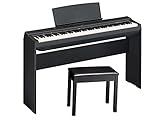



Last update on 2025-04-15 / Affiliate links / Images from Amazon Product Advertising API
Yamaha P45 vs P125: Differences
Since the Yamaha P125 is the better piano, I found that it beat out the P45 by 3-2 when comparing their differences. While the Yamaha P125 is the more expensive option, it does come with more premium features such as sophisticated tone generation, more voices, presets, and a bunch of other things that justify the steeper price tag.
Feel
The winner: Tie
This is arguably the only area where the Yamaha P45 and P125 are tied. Since they have the same type of hammer action and key texture, they both simulate the feel of an acoustic piano. With that said, both models leave a lot to be desired when it comes to this feature.
Hammer Action
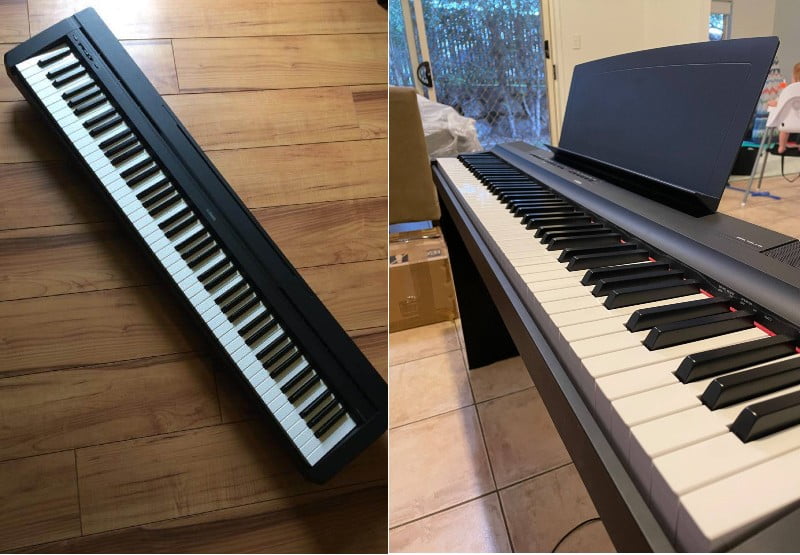
Both of the pianos have GHS, which stands for Graded Hammer Standard. This is a signature feature of many Yamaha keyboards that’s designed to better simulate the hammer action of acoustic pianos. These keyboards both have fully-weighted keys that are heavier towards the left side and lighter towards the right side. This is similar to how acoustic pianos are set up, so if you’re looking for a similar hammer action to acoustic pianos, this is about as close as you can get.
This is a great feature for piano students and pianists alike as it teaches you how to get used to the feel of heavier hammer action, which will make it easier to transition to acoustic pianos. On top of that, as you get better at the instrument, you might find that fully-weighted keys even help you play better!
Key Texture
When it comes to key texture, both of these options are fairly lackluster. While the Yamaha P45 and P125 did a great job with hammer action, their keys have a very plastic-like feel and shine to them. This means that the texture is fairly different from real acoustic pianos. And while this isn’t a glaring flaw, the more you play an acoustic piano, the more you’ll feel the difference with these plastic keys.
Tone
The winner: Yamaha P125
The Yamaha P125 was the clear winner in this regard. It offers better tone generation, a wider sound library, and more robust effects that give pianists more control over their tone.
Tone Generation
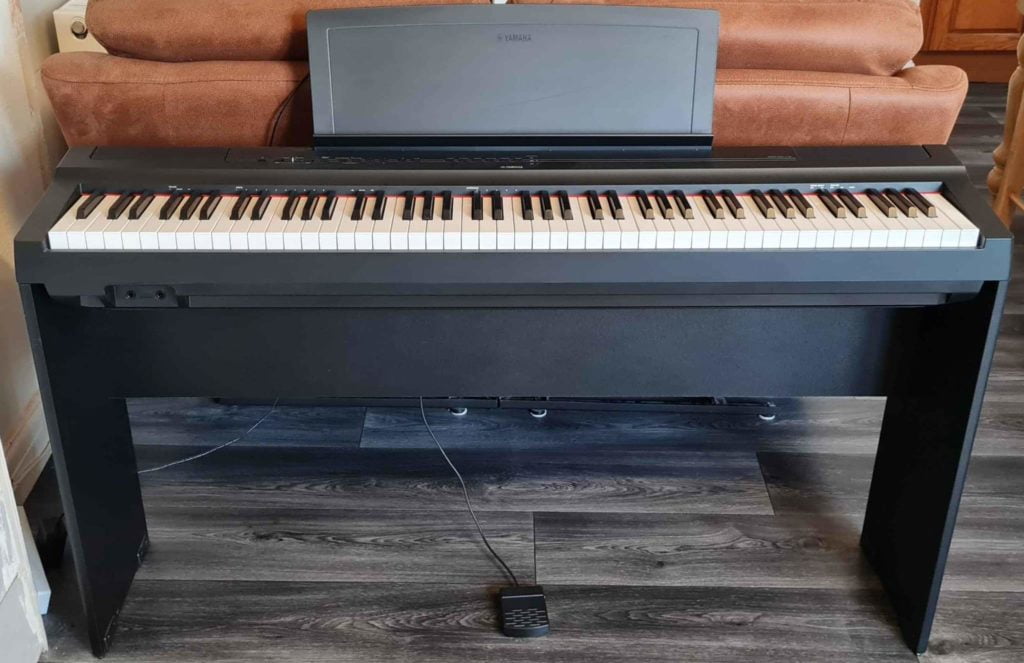
The Yamaha P125 is equipped with the Pure CF Sound Engine while the P45 uses AWM stereo sampling. Both of these tone generation techniques are variations on the standard sampling method. However, after hearing both of the pianos, you’ll find that these variations make a huge difference when it comes to tone.
Let’s start with the P45. AWM stereo sampling captures the full sound of some of Yamaha’s best pianos. When recording the samples, they made sure to capture the natural decay of the piano instead of using artificial decay to preserve memory. This makes for a much more accurate piano tone that’s hard to match in its price range.
While AWM stereo sampling is great, it simply doesn’t compare to the Pure CF Sound Engine. The Pure CF Sound Engine consists of samples recorded from real Yamaha CFIIIS Concert Grand Piano. After listening to the piano tones of both instruments, I found that the P125 reproduced a crisper, clearer, and better piano tone overall.
Sound Library
The Yamaha P125 knocks the P45 out of the park with its robust sound library. It contains up to 24 different voices. THis includes some of Yamaha’s most popular grand pianos, upright pianos, and even includes strings, organ, and electric piano sounds. This gives you a lot of versatility when playing and allows you to play a wide variety of music. In fact, the Yamaha P125 even has a couple of bass sounds to choose from to be the backbone of your band’s music.
Since the Yamaha P45 is best for beginners only, it focuses more on the basic tones and voices you’ll need to start playing. This includes a couple of piano tones, some bass, organ, synth, and strings voices. However, you don’t get as much variety as the Yamaha P125. With that said, the quality of the voices are top-quality with the P45 and are more than enough for beginners to start experimenting.
Effects
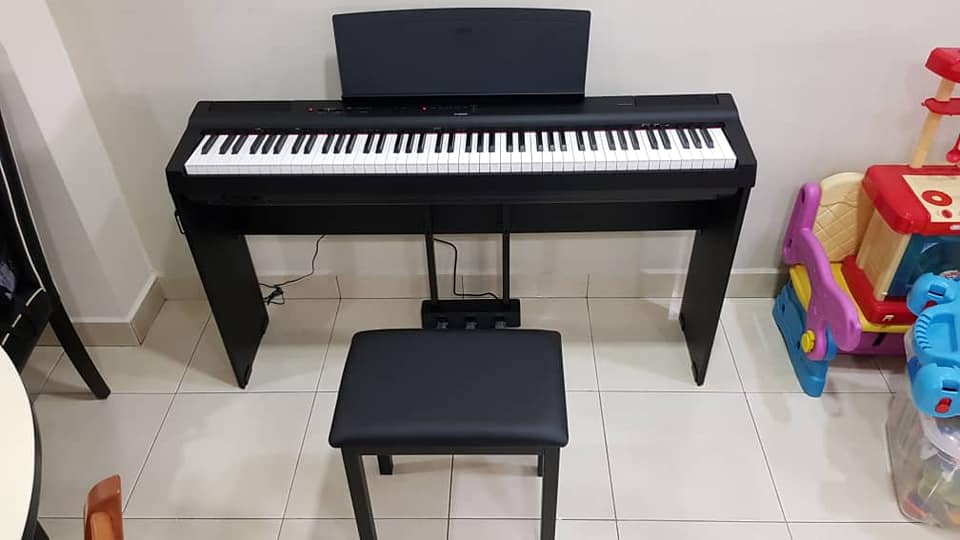
With the P125, you get Reverb, IAC, Damper Resonance, and Sound Boost effects. These can make a significant difference when playing music. Not only does it give you more control over your piano’s final tone, it can be a whole lot of fun. With that said, navigating through all these effects is kind of difficult, but after some practice, you’ll eventually get used to it.
The Yamaha P45 doesn’t have as varied a list of effects. However, it does come with the most basic effect beginner pianists need: Reverb. In fact, it comes with four different types of reverb that you can tweak to your liking. For a beginner, this is more than enough when it comes to tone control. However, as you get better at the instrument, you might find that you need more versatile effects.
Piano Features
The winner: Yamaha P125
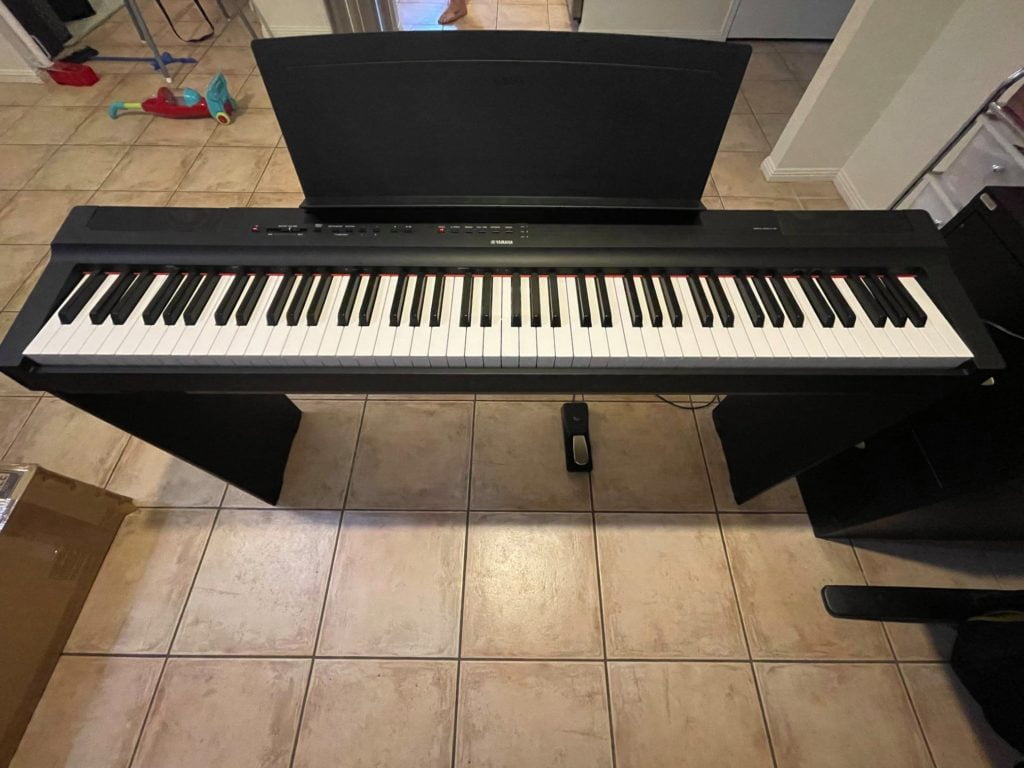
As the more premium option, the Yamaha P125 comes with a bunch of extra features that make it a great instrument. While the P45 comes with Dual mode, the P125 comes with split mode, duo mode, more preset songs, and better connectivity options that make it the better overall pick.
Duo Mode & Split Mode
Duo Mode and Split Mode are key features of the Yamaha P125. With Duo Mode, you can separate the piano into two separate tiny pianos. This is especially useful during piano lessons. With this mode, the student and teacher can play as if they have two different pianos, which can be a great help when it comes to demonstrating different techniques and musical pieces.
Another cool feature is split mode. In this mode, you can assign one side of the piano a specific voice and another voice on the other side of the piano. For example, you can have bass or piano as the voice on the left side and a synth and organ on the right side. This gives the illusion of playing two different instruments at once and offers a lot of functionality, especially for pianists who perform in front of an audience.
One extra feature that’s present on both the P125 and P45 is dual mode. This is also referred to as layering and shouldn’t be mistaken for duo mode. During dual or layering mode, you can assign to different voices at the same time, and each time you press the keys, the piano blends and layers the two sounds together. This is a great feature for beginners and novice players alike as it allows room for a lot of experimentation when it comes to piano tones.
With that said, layering mode is the only extra piano mode available on the P45. While this does beat out a lot of the competition in its price range, it simply doesn’t compare with the robust features on the Yamaha P125.
Accompaniment
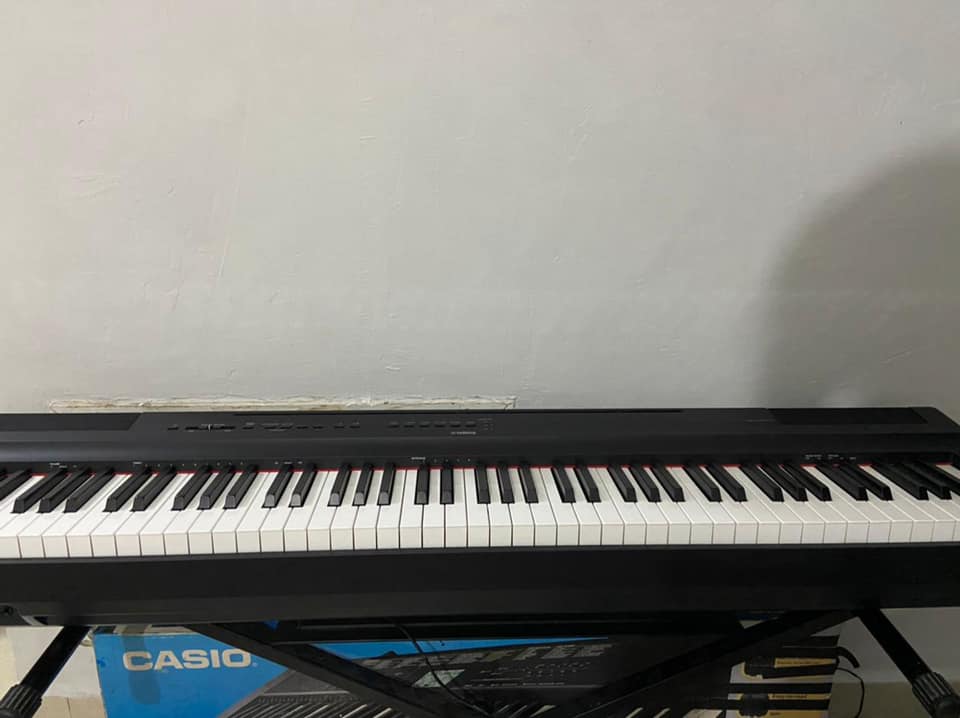
This is another area where the P125 wins by a significant amount. On the P125, you get 21 demo songs and 50 piano songs. This is great for learning new music and jamming out to songs with new techniques that you learn during lessons. The wide variety of demos and piano songs give you a lot of versatility and can make for hours of fun.
The Yamaha P45 also has an accompaniment function, but it isn’t as varied. On the P45, you only get 10 demo songs and 10 piano songs. Now, don’t get me wrong this is still a lot and can make for a lot of fun. But compared to the quantity of songs on the P45, it simply doesn’t stack up.
Connectivity
The P125 doesn’t have MIDI connectivity. So, that means you can’t connect it to your DAW and computer to control virtual instruments. Since this piano was designed for pianists and not producers, this isn’t too much of a drawback. However, the P45 does have USB connectivity which gives it a slight edge in this regard. So, if you want to test out virtual instruments or piano learning apps with the P45, MIDI connectivity allows you to do just that.
However, aside from MIDI, the connectivity options on the P45 are fairly limited. In fact, it doesn’t even have a ¼’’ output at the back for connecting to an external sound system, which the P125 has. On top of that, you can connect the Yamaha P125 to your phone via a wide range of different Yamaha apps. You can use these apps to tweak the tone, learn to play the piano, and much more. Admittedly, this isn’t a feature you’ll use too often, but it does allow for more versatility and control over your piano.
Yamaha P45 vs P125: The Similarities
Both of these instruments are full-key keyboards with GHS weighted keys. This makes both options great for beginners. However, since the P125 comes with more robust features, it’s the better option for those who are really striving to become great pianists. Another similarity between these two is that they are both portable, but if you get a furniture stand for either of these pianos, you can expect the portability to drop significantly.
When testing out these two pianos, I also found that the speakers were fairly similar. The P125’s speakers are slightly better since they are 7W compared to the P45’s 6W speakers, but this isn’t too large of a difference. In fact, I found that the speakers on both of these options are a slight letdown. While they are definitely loud enough for practicing, rehearsals, and playing alone, if you’re playing with other musicians, you’re going to need an external sound system.
Aside from that, and the fact that these two are both made by Yamaha, there aren’t too many similarities between the two options, which is why it was a whole lot of fun creating this comparison.
Quick Rundown of the Yamaha P125
- A fully weighted digital piano with 88 full sized piano style keys
- GHS weighted action is heavier in the low keys and lighter in the high keys, just like an acoustic piano
- The pure CF sound engine faithfully reproduces the tone of the acclaimed Yamaha 9 feet CFIIIS Concert grand piano; Tempo range: 5 to 280
- Split mode lets you play a different voice with each hand; Tuning: 414.8 440.0 to 446.8 hertz
- USB to host connectivity with MIDI and audio transfer means you only need 1 cable to connect to your music making software
Last update on 2025-04-16 / Affiliate links / Images from Amazon Product Advertising API
Quick Rundown of the Yamaha P45
- Includes the P45 Digital Piano, power adapter, sustain pedal and music rest
- 88 fully weighted piano style keys simulate the feel of an acoustic piano and provide a quality playing experience
- GHS weighted action is heavier in the low end and lighter in the high end, just like an acoustic piano
- Contains 10 different voices, including digitally sampled tones from real Yamaha acoustic grand pianos
- Dual mode lets you combine 2 voices together, like piano and strings, for an inspiring new playing experience. Tuning- 414.8 - 440.0 - 446.8 Hz
Last update on 2025-04-16 / Affiliate links / Images from Amazon Product Advertising API
Product Video:
Related Articles to Yamaha P125
- Yamaha P150 vs P125: The Battle of the P-Series Models
- Yamaha P125 vs CLP 625: Can a Beginner’s Digital Piano Match the Clavinova?
- Yamaha P125 vs Roland FP 60: Which is the Better Investment?
- Yamaha P-121 vs P-125: Finding the Best Portable Yamaha Piano
- Yamaha P125 vs Korg LP 380: Which Piano Is Better for Your Needs?
- Yamaha P125 vs P85: Can the Outdated Digital Piano Beat the Newer One?
- Yamaha P125 vs DGX 670: Which Piano Comes Out on Top?
- Yamaha P125 vs Korg SP 280: Which is the Better Beginner’s Digital Piano?
- Yamaha P-255 vs P-125: Finding the Better Option for Beginners
- Yamaha P125 vs YDP S34 Comparison: Does the Portable P125 Hold Up Against a Console Digital Piano?
- Yamaha P125 Vs YDP 164: Should You Get A Console Or Digital Piano?
- Yamaha YDP 103 Vs P125: Should You Get a Portable or Console Digital Piano?
- Yamaha P125 Vs Kawai ES110 Comparison: Which Is The Best Portable Digital Piano
- Yamaha P125 vs Casio PX S1000: Which Digital Piano Is Worth Your Money?
- Casio PX-870 Vs Yamaha P-125: Should You Get A Portable Or Console Digital Piano?
- Alesis Recital Vs Yamaha P125: Which Is The Right Pick For You?
- Yamaha P45 VS P115: Which P-Series Newbie Gives You More Value for Money?
- Alesis Recital Pro vs Yamaha P125 Comparison: Which Is The Best Portable Digital Piano?
- Alesis Prestige Artist vs Yamaha P125 Comparison: Why the Yamaha P125 Is the Better Investment
- Yamaha P125 vs Casio PX-770 Review: Why the Yamaha P125 Beats Out the Casio Console Digital Piano
- Yamaha P125 vs DGX 660 Comparison: Can the P125 Hold Its Own Against the DGX 660?
- Yamaha P125 vs Roland FP-30X Review: Why the Roland FP-30X Comes Out On Top
- Yamaha P125 vs P515 Review: Why the Yamaha P515 Is the Better Investment
- Yamaha P115 vs P125 Review: Can the P125 Beat Out Its Predecessor?
- Yamaha P125 vs Roland FP30: A Close Battle Between Two Great Digital Pianos
- Yamaha P71 vs P125: Why the Yamaha P125 Is the Better Investment
Related Articles to Yamaha P45
- Yamaha P45 vs P45B: What’s the Real Difference?
- Yamaha P45 vs DGX-650: Is the DGX-650 Worth the Higher Price?
- Yamaha P-35B vs P45: Finding the Best Affordable Yamaha Piano
- Yamaha P45 Vs DGX-660: A Head-to-Head Comparison
- Yamaha P45 vs Williams Rhapsody II: A Head-to-Head Comparison
- Yamaha P45 Vs NP32: A Head-to-Head Comparison
- Yamaha P45 vs Williams Allegro III: Finding the Best Digital Piano on a Budget
- Yamaha P45 vs YPG 535: Which Is the Best Affordable Yamaha Piano?
- Yamaha P60 vs P45: Finding the Best Yamaha Portable Digital Piano
- Yamaha P45 vs P105: Should You Spend Extra for the P105?
- Alesis Recital Vs Yamaha P45: Which Offers Great Value For Money?
- Donner DEP-10 Vs Yamaha P-45: Which Digital Piano Is Better?
- Yamaha P45 Vs Korg B2: Which Digital Piano Fits Beginners Better?
- Yamaha P45 VS P115: Which P-Series Newbie Gives You More Value for Money?
- Yamaha P45 vs Casio CDP S100: Finding the Better Bet for Beginners
- Yamaha P45 vs YDP 103: Should You Get a Portable or Console Digital Piano?
- Alesis Recital Pro vs Yamaha P45: Which Should You Get As Your First Piano?
- Yamaha P45 vs Roland FP10: Which Entry Level Titan Takes the Top Spot?
- Yamaha P45 vs Donner DEP 20: Which Model Is the Better Option for Beginners?
- Yamaha P45 vs Casio PX 770: Should You Get the Portable or Console Digital Piano?
- Alesis Prestige Artist vs Yamaha P45: Can Alesis Hold Its Own Against the Popular Yamaha Model?
- Yamaha P71 vs P45: Why the Amazon Exclusive P71 is the Better Digital Piano
References:
- P-125: https://usa.yamaha.com/products/musical_instruments/pianos/p_series/p-125/specs.html#product-tabs
- Yamaha P-45 88-key Digital Piano with Speakers: https://www.sweetwater.com/store/detail/P45BK–yamaha-p-45-digital-piano
Lulacruza is an electronic folk duo operating at the junction of the hypermodern and the ancient. Our music weaves together hypnotic female singing, South American folk instruments and electronic processing, while channeling pulsating waves from the source of creation.
Lalucruza is also a community where you can connect with other music lovers to collaborate, exchange ideas and share knowledge. A platform for who wants to learns the basics of playing piano, guitar, drum masters’ technique, etc.. is the premise of our website.
